83fac40774165e776003493ee2461a2d.ppt
- Количество слайдов: 68

Pattern Theory Presentation By Sahar Pirmoradian Adapted from Ulf Grenander, Brown University

Pattern Theory l Not Pattern Recognition l l Not just classifying objects A mathematical formalism, A pattern Algebra l l reconstructing the processes and events that produced real structures The genesis of the observation = Transformation of some ideal images using various transformations

Generators l Building blocks l l l Generating observed signal Denoted by g Generator Space: G l The set of all generators

Similarity Group l To represent symmetries and invariance of patterns: l Similarity Group S (Group of Transformations) l s: elements of this group l s is a bijective mapping: l g 1 and g 2 are similar IF there exists a similarity s such that g 2 = sg 1

Bonds l To build larger structures: l Generators’ interfaces: Bonds (b) § In the example: b 1, b 2, b 3, b 4, b 5

Bonds l Arity (ω(g)), the number of bonds of generator g l l l In the example: ω (g)= 5 ωin (g) = 2 ωout (g) = 3

Bonds l bond value (β): l l l Assigned to each bond In the example: {β 1, β 2, β 3, β 4, β 5} IMPORTANT IN COMBINATION OF GENERATORS

Bonds l Bond Structure is S-invariant: l l If g 1 and g 2 are similar => they have the same bond structure Bond Value is not S-invariant.

Configurations l l Generators ~ Atoms Configurations ~ Molecules

Configuration Diagram l l l Configuration c = σ(g 1, … g 5) Internal bonds: connected bonds External bonds

Bond Value Relation l In a connector graph σ l ρ : Bond value relation l ρ: Bv X Bv -> {True, False} § l l Bv: set of bond values IF ρ (βi, βj)= True => Pair (βi, βj) is REGULAR. IF ρ (βi, βj)=False => Pair (βi, βj) is IRREGULAR.

Connection Type l Connection type: Σ l The family of connector graphs σ(g 1, … gn) l l l Σ = LINEAR Σ = TREE Σ = LATTICE

Regularity l A Configuration c is: l Locally regular l l If all ρ of internal bonds are true Globally regular l l If c is both Locally & Globally regular => c is Regular

Configuration Space l C(R): configuration space l l l The set of all Regular Configurations Where R=<G, S, ρ, Σ > Referred to as a Regularity

Probabilities l l ρ is binary We should define: l A continuum valued function l Acceptor Function, l A(. , . ) on B x B, non-negative real value l Q(. ), non-negative weight function l Making probabilities depend on generators themselves Z: partition function l

Probability l The probability of configuration c with the connector graph σ(g 1, … gn)

Energy l l E: interaction energy T: temperature, positive constant

Patterns of Thought An application of Pattern Theory

Patterns of Thought l Generators: physical things, non-physical things, events

Modality l G is partitioned into subsets: l l Modalities Color, Movement, …

Modality

Thought l Configurations: Thoughts l l l Regular thoughts Completely regular thoughts MIND(R): The set of all (completely) regular thoughts

Modality Group l Similarity Group: l l l Modality Group Generators in a same modality are similar Generators can be substituted

Thought Pattern l A subset is called a thought pattern if it is invariant with respect to the modality group S

Thought Pattern l Example: l Mary strokes the very happy cat

Thought Pattern l Different Topologies of Thought Patterns

l Probabilities of Thought l Energy l Conscious thoughts, unconscious thoughts

Mental Dynamics l Simple Moves: l l l Add a new generator Delete a generator and its connections Delete a connection Create a connection Replace a generator by another generator

Mental Dynamics l Replace

Composite Moves l Delete + Replace

l ABSTRACTION l If a thought occurs more than occasionally: thought = (married ↓human. M and human. F) g = marriage

l SIMILARITY

l COMPOSITION

l MUTATION

l CROSSOVER

l SPECIALAZION

l Generalization l MOD(bark↓Rufus) = (animal_sound↓animal. M)

l Mind Development (memory)

Living alone l Without any Input

Data Structure

Data Structure - Example

Themes of a person suffering from schizotypal personality disorder: l. Ideas of reference l. Magical thinking l. Unusual perceptual experience l. Odd speech l. Paranoid l. No ideation close friend l. Constricted l. Eccentric affect behavior l. Social anxiety

Flow chart start thinking 1 Time? no end Changing Theme yes thinking 2 Remembrance thinking 3

Thinking 1 1. 2. 3. 4. 5. 6. Think 3. m Add generators in L 3 Show conscious thought Save top_3_ideas and top_2_ideas Update memory Show idea

Thinking 2 1. 2. 3. 4. 5. 6. 7. Composite moves (composite_moves 1. m) Connect open down bonds Add generators in L 3 Show conscious thought Save top_3_ideas and top_2_ideas Update memory Show idea

Thinking 3 1. 2. 3. 4. 5. 6. 7. Composite moves (composite_moves 2. m) Connect open down bonds Add generators in L 3 Show conscious thought Save top_3_ideas and top_2_ideas Update memory Show idea

Think 3 l Think 3. m l l l Content = build_thought_2. m Add_generator_new. m connecting down bonds l l Find_open_down_bond. m Connect_down_bond. m
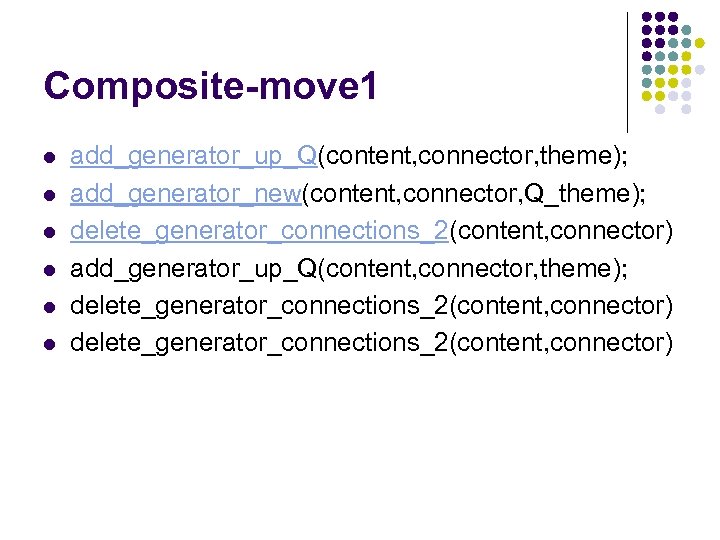
Composite-move 1 l l l add_generator_up_Q(content, connector, theme); add_generator_new(content, connector, Q_theme); delete_generator_connections_2(content, connector) add_generator_up_Q(content, connector, theme); delete_generator_connections_2(content, connector)

Composite-move 2 l l l l l delete_generator_connections_2(content, connector); add_generator_up_Q(content, connector, theme); add_generator_new(content, connector, Q_theme); add_generator_up_Q(content, connector, theme); delete_generator_connections_2(content, connector);

Build_thought_2 build_thought_2. m: l l l Select a random theme Select related modalities to theme Select related generators to the modalities Set Q(g) = 20 else Q=1 Selecting generators in different levels: § § § l With a high probability just one of generators in level 1 is selected. More than one, with same probability are selected Probability of generators in level 4 is zero! Content = 1 626 2 26 3 433 Backgammon (modality: Plays ) Dance (modality: Move) Lose (modality: Outcome)

Add_generator_new l Add_generator_new. m l l Select a generator regarding Q Probability of adding the selected generator g: (mu=2) l l l P = mu/(n+1) * Q(g) P = p / (p+1) If select (p, 1 -p) == 1 then add g to content
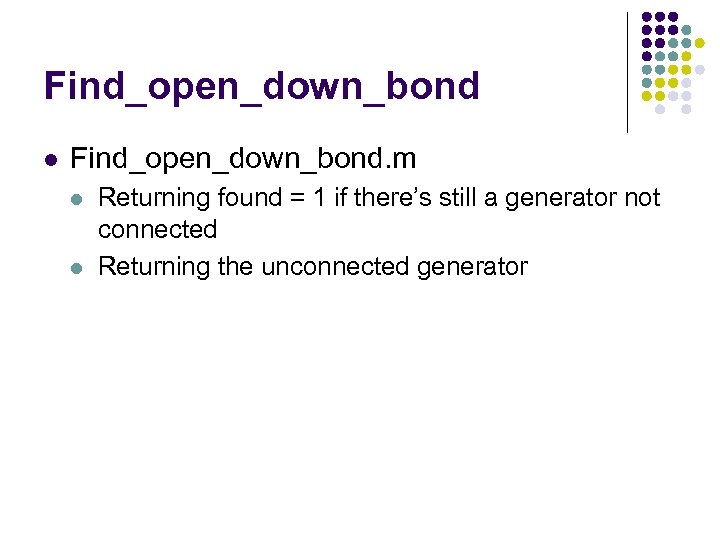
Find_open_down_bond l Find_open_down_bond. m l l Returning found = 1 if there’s still a generator not connected Returning the unconnected generator

Connect_down_bond l Connect_down_bond. m: l Find all of generators may be connected to the unconnected generator l l Finding the modality of the g Finding the acceptable modalities for down bond connection of the g Finding all the generators of the acceptable modalities Search the acceptable generators in the mind
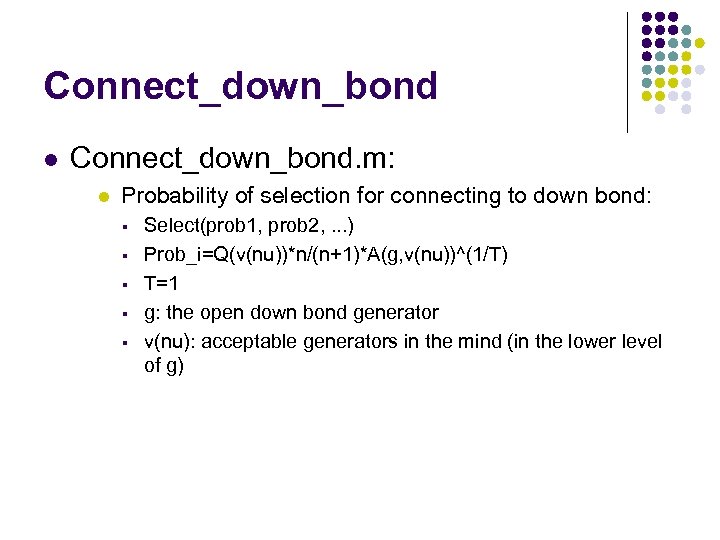
Connect_down_bond l Connect_down_bond. m: l Probability of selection for connecting to down bond: § § § Select(prob 1, prob 2, . . . ) Prob_i=Q(v(nu))*n/(n+1)*A(g, v(nu))^(1/T) T=1 g: the open down bond generator v(nu): acceptable generators in the mind (in the lower level of g)
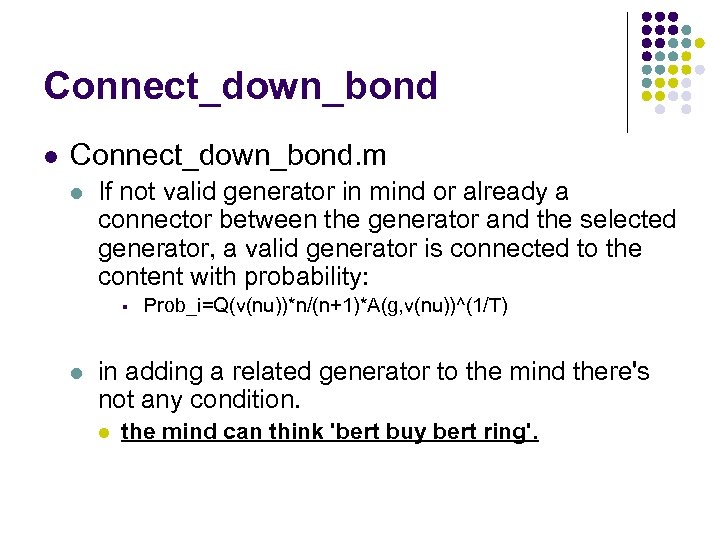
Connect_down_bond l Connect_down_bond. m l If not valid generator in mind or already a connector between the generator and the selected generator, a valid generator is connected to the content with probability: § l Prob_i=Q(v(nu))*n/(n+1)*A(g, v(nu))^(1/T) in adding a related generator to the mind there's not any condition. l the mind can think 'bert buy bert ring'.
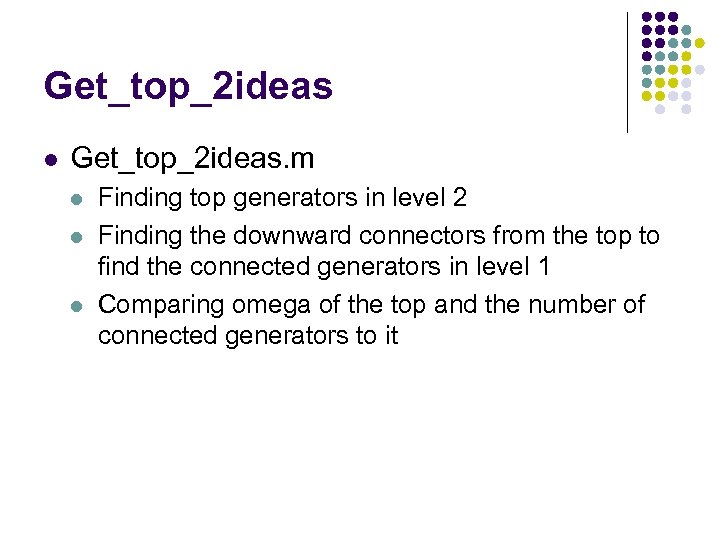
Get_top_2 ideas l Get_top_2 ideas. m l l l Finding top generators in level 2 Finding the downward connectors from the top to find the connected generators in level 1 Comparing omega of the top and the number of connected generators to it

Add_generator_up_Q l Add_generator_up_Q: l l Selecting randomly one of generators in content Finding valid generators to be connected upward to the selected generator, regardless of mind Computing the probability of each valid generator based on their Qs and As. Connecting two selected generators with each other on the valid omega.

Delete_generator_connection_ 2 l Delete_generator_connection_2: l If connector is empty, delete first member of content with the probability: (mu = 2) l l l g = content(1, 2) prob_del=(n/mu)/Q(g); %check this! prob_del=prob_del/(1+prob_del); if select([prob_del, 1 -prob_del]), delete, end All the downward and upward connections from the content(1, 2) will be found
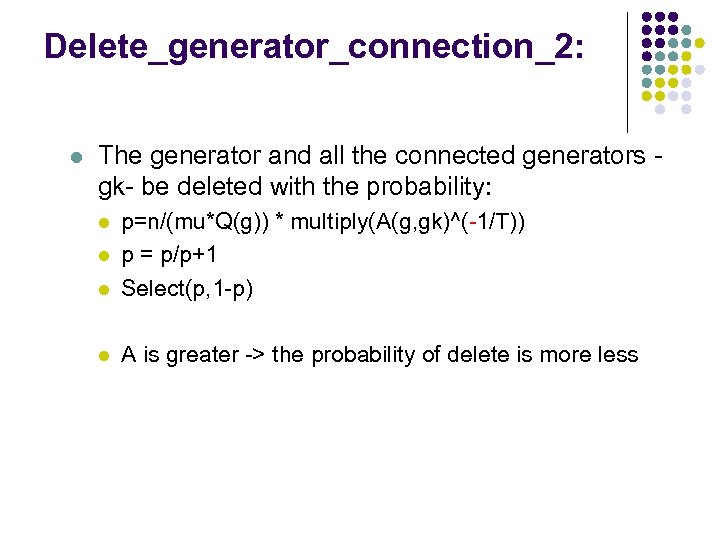
Delete_generator_connection_2: l The generator and all the connected generators gk- be deleted with the probability: l p=n/(mu*Q(g)) * multiply(A(g, gk)^(-1/T)) p = p/p+1 Select(p, 1 -p) l A is greater -> the probability of delete is more less l l
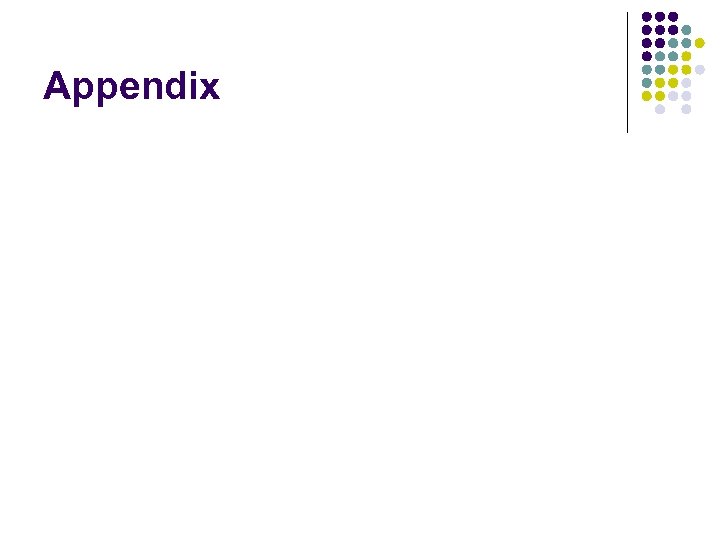
Appendix
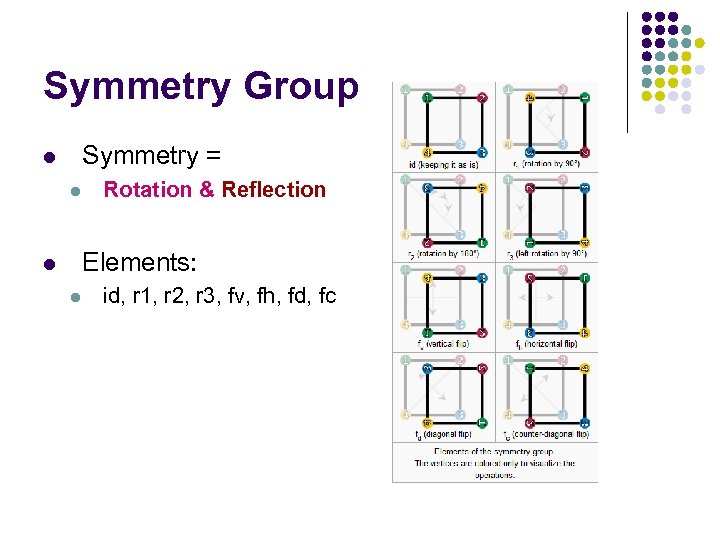
Symmetry Group Symmetry = l l Rotation & Reflection Elements: l l id, r 1, r 2, r 3, fv, fh, fd, fc
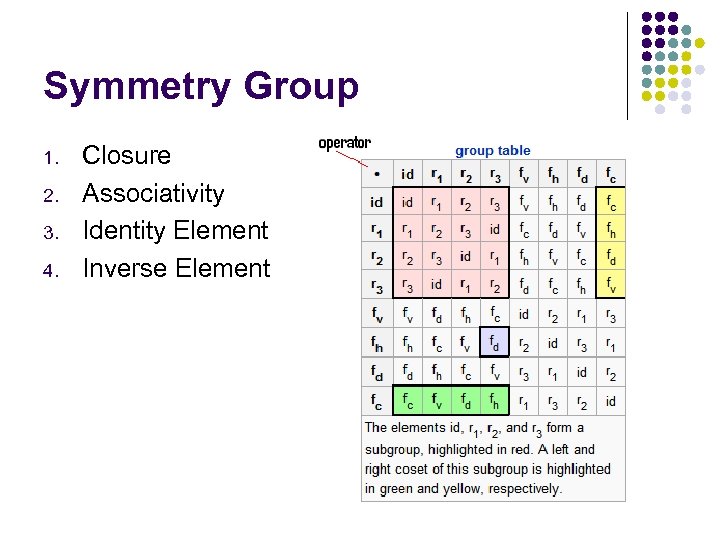
Symmetry Group 1. 2. 3. 4. Closure Associativity Identity Element Inverse Element

Bijective Function l bijective function is a function f from a set X to a set Y with the property that, for every y in Y, there is exactly one x in X such that f(x) = y.
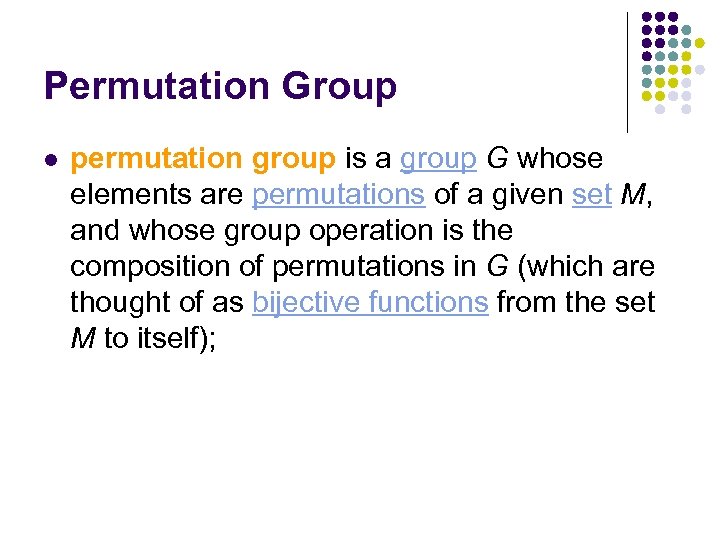
Permutation Group l permutation group is a group G whose elements are permutations of a given set M, and whose group operation is the composition of permutations in G (which are thought of as bijective functions from the set M to itself);
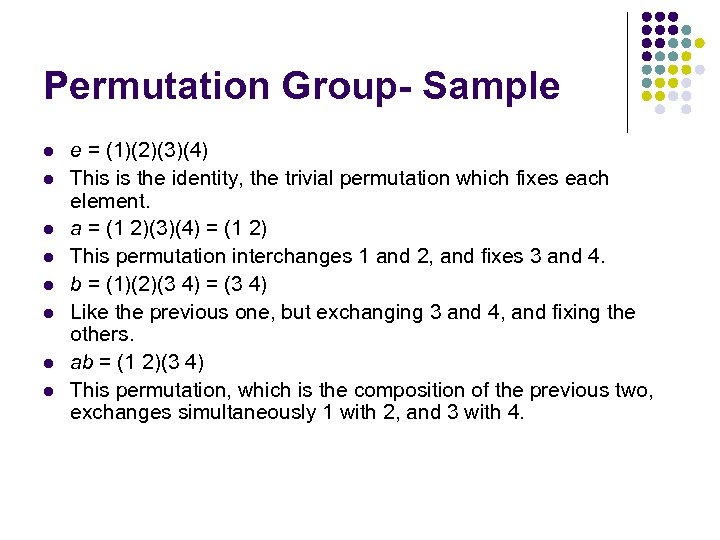
Permutation Group- Sample l l l l e = (1)(2)(3)(4) This is the identity, the trivial permutation which fixes each element. a = (1 2)(3)(4) = (1 2) This permutation interchanges 1 and 2, and fixes 3 and 4. b = (1)(2)(3 4) = (3 4) Like the previous one, but exchanging 3 and 4, and fixing the others. ab = (1 2)(3 4) This permutation, which is the composition of the previous two, exchanges simultaneously 1 with 2, and 3 with 4.
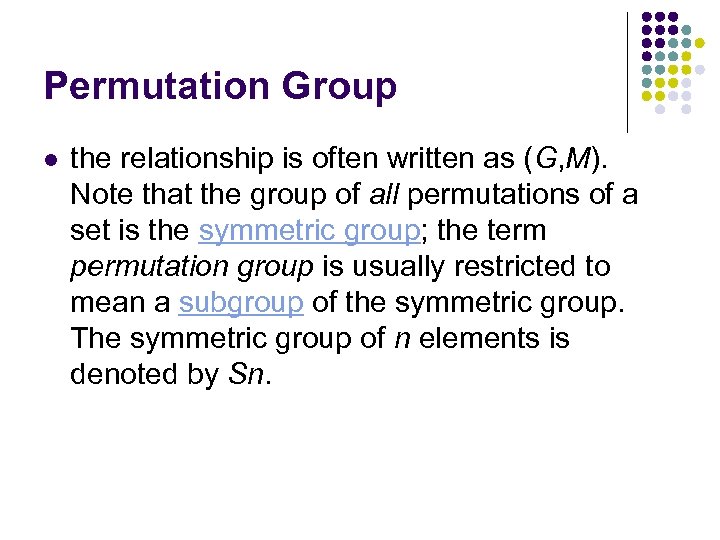
Permutation Group l the relationship is often written as (G, M). Note that the group of all permutations of a set is the symmetric group; the term permutation group is usually restricted to mean a subgroup of the symmetric group. The symmetric group of n elements is denoted by Sn.
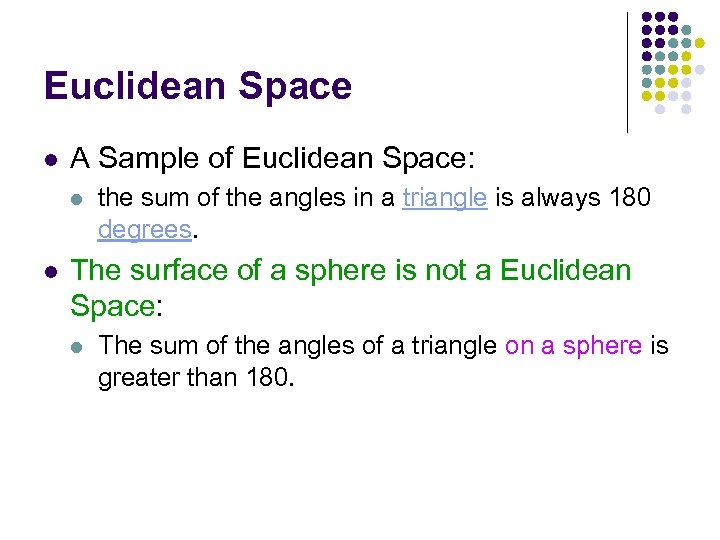
Euclidean Space l A Sample of Euclidean Space: l l the sum of the angles in a triangle is always 180 degrees. The surface of a sphere is not a Euclidean Space: l The sum of the angles of a triangle on a sphere is greater than 180.
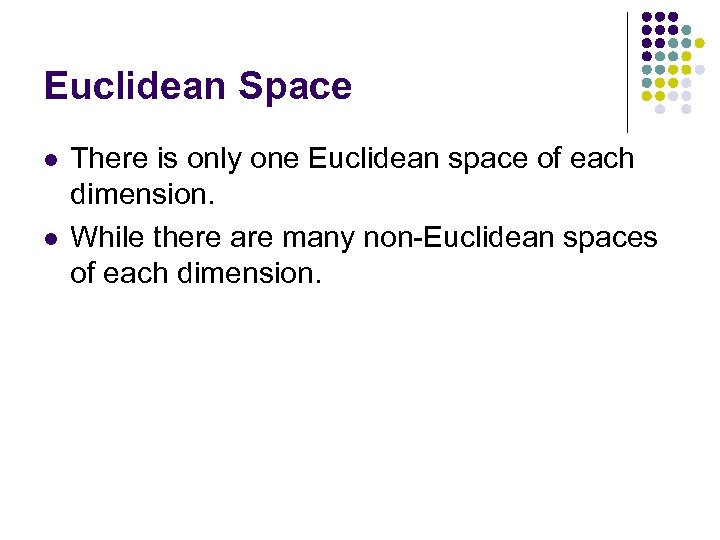
Euclidean Space l l There is only one Euclidean space of each dimension. While there are many non-Euclidean spaces of each dimension.
83fac40774165e776003493ee2461a2d.ppt